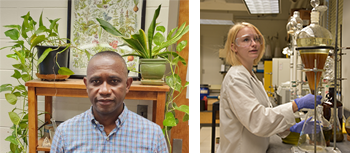BENFRA Collaborations
R03 projects
R03 projects
Evaluation of the potential of Ashwagandha extracts to produce CYP-mediated drug interactions
Investigators: Robert Arnold, Ph.D. and Angela Calderon, Ph.D.
Auburn University
R03AT011501
Our R03 project propose to evaluate Ashwagandha (Withania somnifera), for the potential of botanical-drug interactions due to inhibition and induction of the most important Phase I drug metabolizing enzymes, the cytochromes P450 (CYPs). To date, there have been limited reports regarding the inhibitory effects of Ashwagandha extracts on the CYPs, and no published studies examined whether Ashwagandha extracts have the potential to induce CYP expression. Ashwagandha is used by older adults in particular to ameliorate stress, insomnia, and cognitive deficiencies; and this population is often taking conventional medications for other health conditions. Thus, use by the elderly makes a study of how Ashwagandha affects CYP activity and expression an important concern.
Ashwagandha is one of two botanicals being studied for its ability to improve resilience in the BENFRA Botanical Dietary Supplements Research Center (BDSRC) at Oregon Health and Science University (U19 AT010829). Our work will synergize with that of the BENFRA BDSRC, which will provide authenticated and chemically characterized extracts of Ashwagandha roots and leaves for testing in the applicant’s laboratory at the University of Auburn.
For our project, we propose two Specific Aims. In Aim 1, we will screen different types of Ashwagandha extracts for inhibition of nine human hepatic CYPs (including all CYPs recommended for drug-drug evaluation by the FDA). Inhibition of CYPs in pooled human liver microsomes will be measured using CYP probe substrates and our ultrafast UHPLC-MS/MS cocktail assay. In Aim 2, we will assess induction of CYP mRNA expression caused by Ashwagandha extracts using primary human hepatocytes in sandwich culture according to the FDA Guidance on in vitro drug-drug interactions studies. The resulting comprehensive data of Ashwagandha extract-CYP interactions will be made available through scientific publications.
Personnel


Centella asiatica effects on neuroinflammatory responses in Drosophila models of acute inflammation and aging
Investigators: Lukasz M. Ciesla, Ph.D. and Urmila Maitra, Ph.D.
University of Alabama
R03AT011871-01
Aging is characterized with dysregulated immune function contributing to the decline in biological resilience and increasing vulnerability to death. Aging individuals develop inflammaging, a state characterized by elevated levels of inflammatory cytokines, which contribute to the increase in chronic morbidity, frailty and lead to deterioration of neurological and functional resilience in the elderly. There are no approved interventions currently available to counteract the deleterious effects of inflammaging. Certain lifestyle modifications such as regular physical activity, calorie restriction and plant-based diet have been associated with decreased levels of chronic inflammation resulting in slowed biological aging. Numerous botanical dietary supplements are currently available on the market with claim to improve resilience to age-related deterioration in cognition, sleep or mood. However, the molecular mechanism of action for most of these formulations remains unknown.
The BENFRA Botanical Dietary Supplements Research Center at OHSU has been involved in evaluating the potential of the Ayurvedic plant Centella asiatica (gotu kola) in alleviating age-related neurological changes. The research performed at the center has demonstrated that hot water gotu kola extract (CAW) has positive effects on antioxidant response, mitochondrial activity and synaptic health in both in vitro and in vivo preclinical mouse models. However, the previous research at the BENFRA center has not assessed the potential of standardized CAW extract to reduce brain specific inflammation in in vivo models of aging or acute neuroinflammation.
In this project we propose to test the ability of CAW to ameliorate acute and age-related neuroinflammation in the genetically tractable organism Drosophila melanogaster. Similar to mammals, transcription of pro-inflammatory molecules in Drosophila is mediated by the evolutionarily conserved transcription factor NF-κB, whose activity also increases with age. Here, we will evaluate the effects of CAW on neuroinflammation in aging wild type Drosophila, in Drosophila with constitutively active innate immune system undergoing accelerated aging, and in a Drosophila model of Paraquat (PQ)-induced oxidative stress. In each model, using optimized CAW feeding regimens, we will assess survival, the levels of brain-specific inflammatory gene expression or oxidative stress markers. Moreover, we will test the effects of CAW on neurological outcomes by measuring mobility behavior and vacuolar neuropathology in brain tissue. This research will verify whether CAW lowers levels of inflammation in in vivo models of acute neuroinflammation and aging, and if it ameliorates associated neurological phenotypes. A demonstration that CAW can affect inflammaging will serve as the basis of including biomarkers of inflammation as important endpoints in future clinical trials of CAW.
Personnel

Development of an In-House Proton Spin Network Database to Characterize the Pharmacophores of CA for Standardization and QC
Full title: Development of an In-House Proton Spin Network Database to Characterize the Pharmacophores of Centella Asiatica for Standardization and Quality Control
Investigator: Liva Rakotondraibe, Ph.D.
Ohio State University
R03AT011872-01
The benefits of dietary supplements (DS) including botanicals are well documented as they are consumed by about half of the adult population of the United States. For safety and batch-to batch consistency purposes, the identification and characterization of chemical constituents of DS of plant origin have to be performed although the complexity of the mixture and the possible activity contributions of many of the constituting components make the task challenging. Liquid chromatography coupled with mass spectrometry (LC-MS)-based methods are the most reliable so far in the identification and characterization of already known bioactive compounds in a botanical DS. More reliable and updated mass spectrometric databases and methodologies as well as new complementary methods are, however, still needed for rapid metabolite identification, activity consistency, and batch-to-batch quality controls. NMR spectroscopy has long been used with mass spectrometry in metabolomics profiling of natural products and to determine unambiguously structures of organic compounds. Most profiling in many NMR-based metabolomics studies, however, focus only on identifiable (or already known) major compounds, leaving the identification of overlapping signals arising from complex mixture of compounds as major challenges. Furthermore, pure authentic standard compounds display proton and carbon signals with chemical shifts slightly different from those of the same compounds in a mixture and these chemical shift differences make NMR-based metabolomics difficult if not inaccurate.
Nevertheless, the shape and the splitting of the signals due to coupled protons in spin networks remain the same, despite mixture-enhanced resonance shifts. These unchanged spin network characteristics can be identified by selective one-dimensional TOCSY (S1DT) experiments, which use pulse sequences that show signal sensitivity increase, especially when high-field strength NMR and high number of scans are used. Moreover, many isomers that are undiscernible in most MS analyses can be differentiated using their S1DT fingerprint generated characteristic spin networks.
Our overall goal is to couple the identified S1DT fingerprint information with the existing mass spectrometric data information on Centella asiatica (gotu kola) currently available at BENFRA Botanical Dietary Supplements Research Center (NIH/NCCIH U19 AT010829) and those of compounds isolated during the present study to complement LC-MS for batch-to batch quality control and activity consistencies. Aim 1 on comprehensive untargeted isolation will afford reference standard compounds and a robust LC-MS database that will be used for identification and standardization studies at the center and other research communities working on C. asiatica. In addition, a new application of S1DT that will help to accurately identify chemical constituents and their potential pharmacophores by comparing 1H spin network fingerprints identified in the isolated compounds with those derived from the 1H NMR spectra of the extract will be developed in Aim 2.
Personnel

Effects of digestion on composition and bioavailability of compounds from Ashwagandha: an in vitro study
Principal Investigator: Wendy Strangman Ph.D.
University of North Carolina Wilmington
R03AT012460
This project will provide detailed information on the fate of substances found in Ashwagandha once they are ingested. These data will provide a picture of which components are altered during digestion and which original and altered compounds from Ashwagandha might be absorbed into the bloodstream; information that is critical for future studies examining Ashwagandha’s health effects.
Withania somnifera, has long been known in Ayurvedic medicine for its medicinal properties. In recent years, consumption of W. somnifera products has skyrocketed in western cultures where they are now marketed through retail outlets as dietary supplements, under the common name, Ashwagandha. Unlike pharmaceutical drugs which have an extensive evaluation process prior to public distribution, very little is known regarding how the complex mixture of chemicals present in Ashwagandha extracts behaves once it is consumed and passes through the digestive environment.
This project will evaluate metabolic stability of Ashwagandha extracts created in the BENFRA center for the first time using in vitro laboratory models simulating the gastrointestinal environment. The project will also assess which original or modified components are able to pass the intestinal membrane via passive diffusion, the mechanism by which most compounds enter the circulation from the gut. The central hypothesis of this research is that the composition of Ashwagandha derived metabolites entering circulation is markedly different from that of the original extract. This hypothesis will be tested through the following specific aims:
- Determine effects of gastrointestinal environments on the metabolite profiles of Ashwagandha extracts by exposing extracts to simulated gastro-intestinal fluids and enzymes; and
- Identify permeabilities of metabolites from Ashwagandha original extracts and digestive incubations using a synthetic model of the intestinal membrane.
We will use a combination of these in vitro model systems, appropriate controls, and sufficient replicates for robust statistical analyses to standardize these initial investigations. Ultra-pressure liquid chromatography coupled with high resolution mass spectrometry will be used to analyze extracts, incubates, and diffusion chamber media, to evaluate changes in chemical structures and relative abundances of Ashwagandha metabolites in these complex matrices for the first time. Results from these studies will provide insight into a more realistic Ashwagandha metabolic profile post-gastrointestinal digestion that can then be further studied collaboratively using established pre-clinical assays. Results of the present study may also highlight permeable metabolites of interest not currently under investigation for bioactivity. In the long term, this project will establish a robust analytical strategy that can be used broadly to assess oral bioavailability of other botanical supplements in an in vitro setting, prior to time, labor, and resource intensive in vivo studies.
Personnel

University of Mainz
University of Mainz
Roland Strauss, Ph.D.
Dr. Roland Strauss’ group at the Institute of Developmental Biology and Neurobiology, Johannes Gutenberg University Mainz, Germany, investigates the effects of Centella asiatica and Withania somnifera on a depression-like state in Drosophila. Dr. Strauss has been a leader in studying memory functions and complex behaviors in Drosophila and his group has been the first to establish Drosophila as a model to induce a depression-like state and study the behavioral consequences. His group is therefore uniquely qualified to perform the experiments that address whether supplementation with Centella asiatica and Withania somnifera extracts provide resilience against depression and anxiety in the Drosophila model.
Dr. Strauss’s group is assisting with studies being performed under BENFRA Project 2.
Members
CARBON
Natural Product Magnetic Resonance Database (NP-MRD)
The BENFRA Center is actively collaborating with Dr. John R Cort, Director of the Natural Product Magnetic Resonance Database (NP-MRD), another component of the NIH CARBON program. The NP-MRD is a comprehensive database and repository for nuclear magnetic resonance (NMR) data of natural products and specialized metabolites. The goals of the collaboration are to (a) support inclusion in the NP_MRD of NMR data on Centella asiatica and Withania somnifera compounds; and (b) develop 2-D heteronuclear NMR as a tool for analysis of complex extracts and fractions from botanicals in general, and Withania somnifera in particular.
Liquid chromatography coupled to high-resolution tandem mass spectrometry (LC-HRMS/MS; available at BENFRA) and heteronuclear NMR (available at NP-MRD) techniques provide different, yet complementary information on the composition of mixtures. LC-HRMS/MS separates components of a mixture, provides data on their molecular mass and allows the calculation of possible molecular formulae. Tentative annotation of compounds can be obtained from the tandem mass spectral data, which are searched against relevant spectral databases. However, database matches are not always available, and compound identification can only be achieved by conducting co-elution experiments with authentic standards, or by an orthogonal method, such as NMR spectroscopy.
Importantly, NMR spectroscopy can assist in elucidating the unambiguous chemical structure of novel compounds and allows profiling of the types of compounds found in a mixture based solely on chemical shifts and correlations of 1H and 13C resonances observed in the fingerprint-like 2-D HSQC NMR experiment. Such data also allows the identification of components based on signals arising from the same molecule even when present in a mixture, provided reference data is available in a library such as the NP-MRD. Therefore, the combined use of LC-HRMS/MS and NMR to identify compounds or characterize components of a mixture is optimal. We have successfully applied this joint approach to the analysis of fractions of Withania somnifera, demonstrating through both LC-HRMS/MS and heteronuclear NMR that fraction that was active in certain BENFRA bioassays did not contain detectable levels of withanolides, whereas withanolides were present in an inactive fraction. Ongoing collaborative studies between BENFRA and NP-MRD are underway to identify the non-withanolide compounds present in the active fraction.
High Content Functional Annotations of Natural Products (HiFAN Center)
The BENFRA Center is actively collaborating with researchers from the HiFAN Center (High Content Functional Annotations of Natural Products), directed by Dr. John MacMillan, another component of the NIH CARBON program. The goal of the collaboration is for HiFAN to apply the nanostring gene expression technology to mouse samples from BENFRA project 1 to monitor changes in neuroinflammation. Specifically, the HiFAN center is able to analyze mouse tissue samples and assess 757 genes covering core pathways and processes related to neuro-immune interactions using the nCounter® Mouse neuroinflammation panel. The BENFRA Center has contributed cortical brain samples from old and young mice that were treated either with Centella asiatica incorporated into their diet or a control diet. The objective is to determine if neuroinflammatory gene sets and pathways are altered in the aged mice compared with young animals and to investigate whether Centella asiatica treatment can reverse those alterations. Currently, data collection and analysis is still ongoing.
Optimizing this high-throughput technology for use in mammalian tissue samples will provide a powerful tool for analyzing the expression of hundreds of genes simultaneously while using a very small amount of tissue and at a fraction of the cost of traditional arrays. Results from this collaboration will also inform ongoing BENFRA work as it will point to potential mechanisms of action, some of which may be novel.